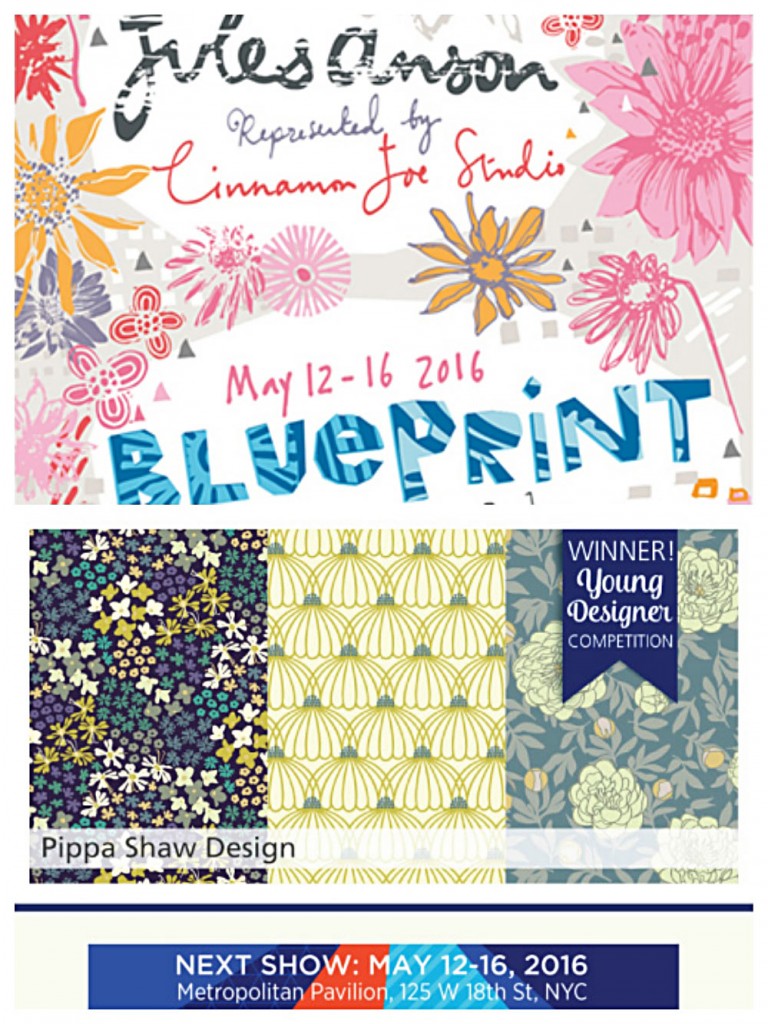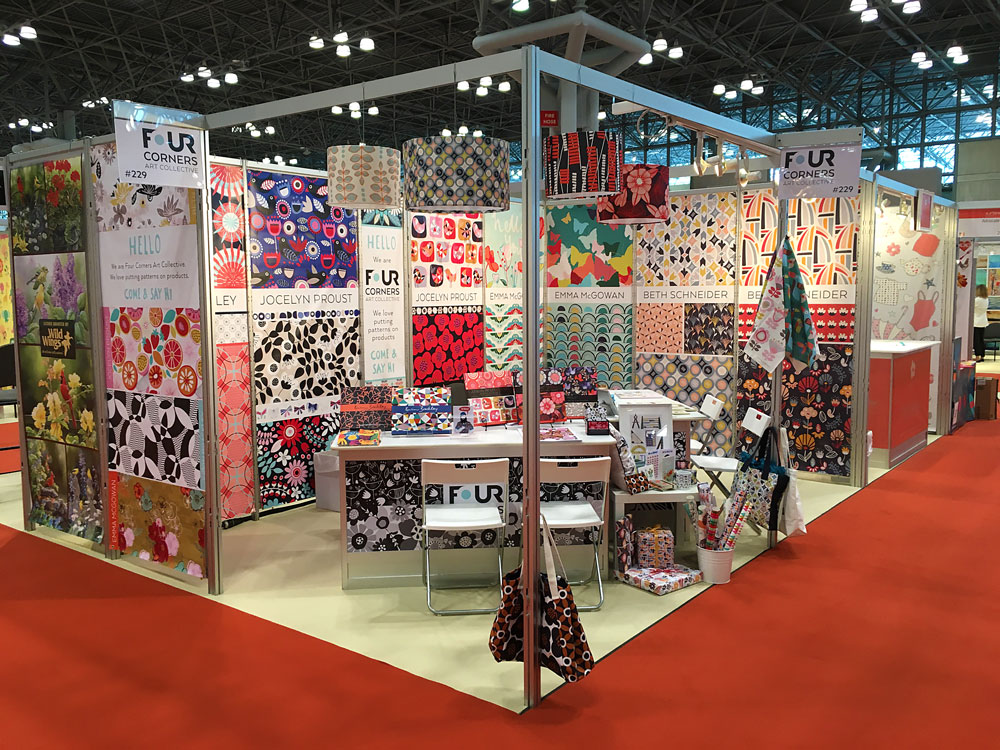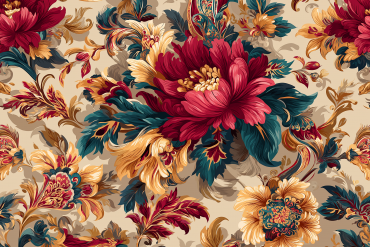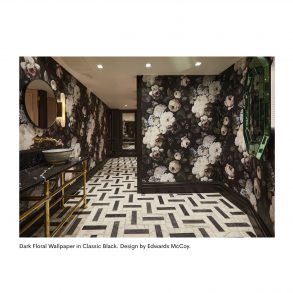This is the third and final installment in a series of guest posts by Four Corners Art Collective. You can read part one HERE and part two HERE.
Last week we explained how the seven members of our collective ended up exhibiting at these three licensing shows: Premiere Vision Paris, Blue Print and Surtex. This week we’ll describe our experiences at each licensing show, how they compared, and what’s been happening since.
Art Licensing Shows

Premiere Vision Paris
Jane: “Premiere Vision is a fashion textile show so all the exhibitors show their work on fabric samples and swatches, or as actual garments. It’s a huge show divided into sections, including an area dedicated to design.
“The Collect team represented me at the stand, so I didn’t actually have to attend, although I did walk the show with Julie and Pippa.
“Buyers are very focused. We watched how people looked at the work, flicking through swatches and rails of samples so fast, it’s clear they know exactly what they’re looking for.
“The downside of selling outright at Premiere Vision as part of a studio is that you don’t make a direct relationship with the companies who buy your work. It made me realize that I’d like to get to know clients and design specifically for them. That’s worth bearing in mind when you choose your show and whether you choose to sell outright or license through licensing shows.
“Despite that, for me this was still a low-cost and low-risk way to make my licensing show debut and I’ll be showing at Premiere Vision with Collect again in September.”
Blue Print

Julie: “It was a dream come true to exhibit in New York so early in my surface pattern career. It was exciting to see my work on the Cinnamon Joe stand and I learned a lot just by comparing how my work looked alongside all the other work.
“People have huge stacks of sell sheets on show, so it’s no wonder that buyers are focused about what they look at. It was really clear that they’re there to make buying decisions and take work away there and then, so they might spend a lot of time at a stand, really looking through stacks of sheets, but they didn’t always browse around other stands afterwards.
“Cinnamon Joe will be representing me again at Blue Print in August and I’m busy working on designs aimed more squarely at stationery and greetings cards companies, because it felt like that was what buyers were really looking for.”
Pippa: “I was at my Blue Print booth all day for all five days of the show, which was amazing but also exhausting! By the end of day one I felt a lot more at ease and knew what questions to ask. It was a great feeling when I sold my first design and to such a lovely client too.
“I made sure to collect as much information as possible from visitors to my stand, so I’d be able to follow up afterwards, but it wasn’t always easy to do because many of the art directors were in a rush and had a lot to see.
“Getting focused feedback from the people that make the decisions has been so helpful. I feel like I have a much better grasp of what art directors are looking for at licensing shows.”
Surtex

Jocelyn: “One thing that really stood out to me was that the atmosphere at Surtex was really friendly. Other exhibitors were open and generous with their knowledge, and the attendees were happy to stop and chat, look at our work and give feedback.”
Kevin: “We were busy non-stop for all three days of the show but Monday was definitely the busiest day. We didn’t even get a chance to stop and grab lunch!
“Meeting people face-to-face means you get a lot of valuable information and insights. Make the most of the opportunity and really engage with what they like and what they’re looking for. And take good notes because it goes by in a blur and it’s amazing what you forget!”
Emma: “Kevin was absolutely brilliant at catching people as they walked by and engaging them in easy, friendly conversation. It’s a real art and he definitely increased footfall to our booth.
“When you invest so much money and time into a show like Surtex, you really need to keep your energy up through the whole three days from start to finish. You never know who’s going to pass by and you don’t want to miss any opportunities.”
Beth: “Our styles are sufficiently different that it felt easy and natural to help clients towards the work that was best suited to their needs, regardless of whose work it was. Which was lucky because we didn’t really plan it that way! It could have been awkward if we’d felt like we were competing with each other, so I’d say think about that before you exhibit with other artists.”
Kevin: “We spent the morning after the show going through all our contact sheets, prioritizing them into piles, which we then split between the four of us and made a plan for how we would follow up.”
Since the shows, we’ve made outright sales, been commissioned for a variety of projects, had our work presented at sales meetings, signed licensing deals and been taken on by selling agents in Korea and Japan. We have a fantastic mailing list of art directors, buyers and agents and are now sending out a monthly new work newsletter.
In the next few months we’ll be sitting down (on Skype) to plan which shows we’ll be doing in the coming year!
About Four Corners Art Collective
Four Corners is an international collective of seven surface pattern designers creating fresh, modern patterns for products and publications. Our work is available to license or buy outright and can be applied across markets – bolt fabrics, apparel, home décor, gift, stationery, quilting, and more. Clients include: Hallmark, The Guardian Newspaper, Dashwood Studio, Workman Publishing, Michael O’Mara Books, Proctor & Gamble, American Flat, and Leap Year Publishing.











